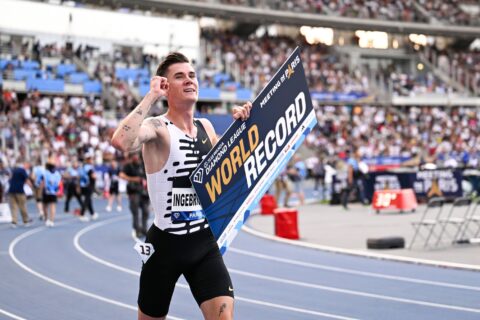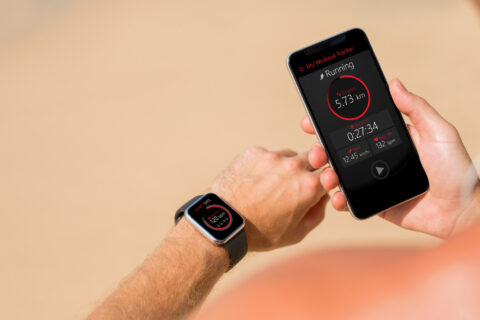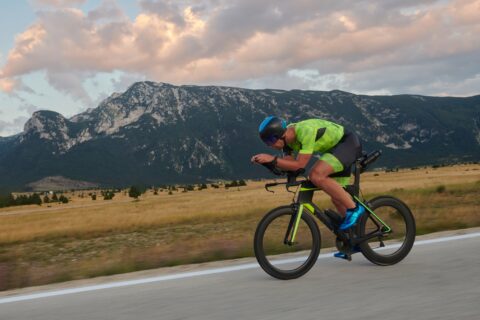Early in Trevor Connor’s bike racing career, he attended a talk by Chrissy Redden, a Canadian Olympic athlete in cycling and speed skating. During her talk, she introduced the idea of keeping a personal “success list” of ideas, approaches, workouts, stretches, and habits.
Think of Trevor’s “Training Book” as his own, personal key to high performance. Everything that’s ever worked for him is contained within the pages of this decades-old book.
Once he became a coach, he gave every one of his athletes a fresh book and asked them to start building their own list of successes.
We are all different. What works for one person isn’t necessarily what works for another. Your training book is your formula for what works for you.
Coach connor
Now Trevor shares some aspects of his training book with you to help you learn what works for you in your own training and racing.
Video Transcript
Trevor Connor 0:09
Welcome to Fast Talk laboratories, your source for the science of endurance performance.
So I have to admit, if my house were on fire and I could only save three things. This would definitely be one of the three things that I would save.
At the very start of my cycling career, I had a little notepad that I carried around with me and I started taking notes on things that I was learning from various people little tricks and tactics that I was learning but it just being a notepad, it was getting wet, it was getting damaged. So I realized I needed more than that, and eventually upgraded to a book. The real stimulus behind this idea was actually a presentation that I went to was by Chrissy Redden who was a Canadian Olympian in both cycling and speed skating. So very experienced athlete, she kept he called her success list, which were the key lessons that she had learned over her career. And she said, having that list and build a review that list is really what you tribute a lot of our assessors to and she told us great stories of being on airplanes and other athletes trying to steal her list. So that I had already started my book that kind of gave me the stimulus for the sort of shape it should take. And I, you’ll see in here, I’ve got various assessed lists throughout.
So I have a racing section I have assesses for that, I have mindset, I have specialists for that I have a recovery section, I keep these assess lists. And each of the here are the things that I have learned that really helped me be at my best. So the most important thing about this book is obviously you can go and buy training books, and there are great training books out there that are going to teach you a lot. But we are all different. What works for one person isn’t necessarily what works for another. And the most important thing to do as an athlete is to learn yourself. So think of this as this is the training book about you. It’s something that you build, as you learn what works for you and you learn also what doesn’t work for you. All that should start going into the book. And ultimately, you end up with something that is, here’s the formula for me. That goes beyond any training plan. Any other book that’s out on the the bookstore, this is the book that describes perfectly what works for you. It really varies. I mean, certainly when I was racing full time I was using this book daily, there are different parts for when I’m doing stretch routines. I’ll go into my mental part and do some of my mental tactics, which are all in this book. When I go to races, the book always comes with me and I have whole sections on what is my warm up routine, what is my prep, what am I slogans for racing, all that’s in there. So I was reviewing it a lot less so now because I’m not racing as much. But certainly, whenever I start feeling off course, when I start feeling like a trainee is just not going well what’s going on, I will often pull out the book, start reading through it, and I can’t tell you how often I will read through something and go, I can’t believe I forgot that. And just reading that reading what I did in difficult times in the past, reading what my mindset what the tactics were I was using during my good years. Those things really helped to get me back on track when I’m off course. So I have found this book so useful for me, this is actually part of my coaching every single athlete that I take on, when I start coaching them, I take them through my book, and then I actually give them a book that I bought for them and encourage them to build out that book the same way I did. So the sections that everybody has should be very personal to them. That’s part of figuring out yourself. So here’s the sections that I have. I like them, but you should really do what you think is best. I do think everybody should start with their their key lessons, I have it my first section is called cycling in a nutshell. Then after that I have mental training. The next section is racing, where I really dive into everything I need to know about racing, then training and recovery, health and injury. And then the final one is my year lessons. I do have a few things that I think everybody should employ. So at the front of my book, I have what I call my compass, which is really what are the most important things that I have learned so those will appear somewhere else in the book. But when it’s something I got man that is just one of the top 12 things I really need to know. I copy those into the front and they have evolved I have rewritten that section probably seven times as I found new things and some things become less important. And that’s expanded a bit I now have a my first section is cycling in a nutshell.
Attributes of a Champion
I have start with what I think are the attributes of the champion.
Cycling Philosophies
And then I have my cycling philosophies.
And in here, I’ve got things I talk about the house, which I’ve talked about on the show I’ve talked about, I have the graph in here, which I’ve also talked about on the show, I’ve talked about the importance of purpose in here. There’s almost nothing that I’ve talked about on the show as a really important thing that actually don’t have in this book is something that I’ve learned the hard way.
Mental Training
Next section for me, is actually my whole mental training section. But I’ve found as he hit a higher and higher level, training becomes less important and really becomes about mindset. And it’s actually one of my largest sections. I have all sorts of things in here to help set my mindset, I have a whole section on what is the the attributes or the mindset of a champion? What are the things that really work for me in terms of keeping my mindset in the right direction, I have a whole bunch of little tactics and techniques I use, I like using slogans that are repeat to myself, particularly before a race. So for example, my first one here, which is a really big one, for me, that really helped my career was embrace stress. So I wrote, it’s going to happen, so don’t fight it, embrace it. So you can get used to it and then learn to use it.
Racing
Probably my biggest section is the race section. And where I start every other section with a success list, I actually have at the front of my race section, pages where I keep my goals for each race. So for example, I have here the say fun race, I’d had a big crowds and previous race. So I wanted to make sure I got through this one pretty well. Competitive every stage, top 10 and final day. So those are my goals. Now, I don’t think it’s enough just to set goals for races. Because saying I want to be top 10 doesn’t tell you how you’re going to get there, what you’re going to do. So I also write focuses in these are the things that during the race I want to focus on that will allow me to accomplish my race. So for example, look through corners, because this is a very technical race, and I was struggling with cornering at the time. I do this for every race, I set my goals and then what I want to focus on for that particular event. If you continue to through the race section, I do have that success list. I have a bunch of other smaller lists of different things to remind myself of race, mental prep is actually in here. But really, the focus of the race section is everything I’ve learned about getting ready and performing well at races. So you can see, I have this little tab here, which I opened up whenever I go to a key race, I open up to this page, and I read through the next 10 pages. And it’s what I do the week before, everything that I’ve learned about my prep for a race, what I do the day before, which includes also my packing list for the race, what I’ve mentioned need to make sure I take to the race, I have my 90 minute routine, which includes a go and get registered. All the different things that you need to do warm up just being part of that, I have figured out a warm up that works well for me, and I’ve got it detailed in here, of exactly when to start it. I mean, I have how far before the race to start it.
Recovery
Then here’s my post race recovery routine. Keep going here is for road races, the things I have learned about road races that really worked for me. And then things I’ve learned about technique, and I can just keep going. So it’s all in here how to race for me. After that I personally have racing, then training and recovery, and then health and injury. So those are what I chose.
Annual Lessons Learned
And then the final one is my year lessons. We’re going to do a whole video on this later. So I’m just going to quickly skim through it now. But I think this is something that every athlete should do at the end of each year. And you can see I’ve got these going all the way back to I think 2004 even even earlier. But it’s just basically doing an assessment of the year, what worked, what didn’t work, what were the key lessons that you learned. So you can go back to these and relearn those lessons.
Jack Daniels’ Running Formula
So I remember a long time ago reading in a book about coaching and training, the author Jack Daniels talked about how time erodes memory, meaning you have a lot of athletes that will hit their peak level, then something will sideline them, they’ll get an injury or they have to take a year off or something like that. And then they’re never able to get back to the level that they used to be at. And his explanation for that was they forget what it took to get to that top level. They forget how hard it is they forget all the things they had to do to get there. And so they’ve lost the formula they can’t get back. That’s part of what this book is about. There are times when we all get off track. There’s times where you’re going to forget things and yours aren’t going to go as well as previous years. If you keep it in here, you avoid that erosion of memory. This is where you can go and remind yourself of all the things that weren’t all the things that you need to do and get yourself back to that top level.



